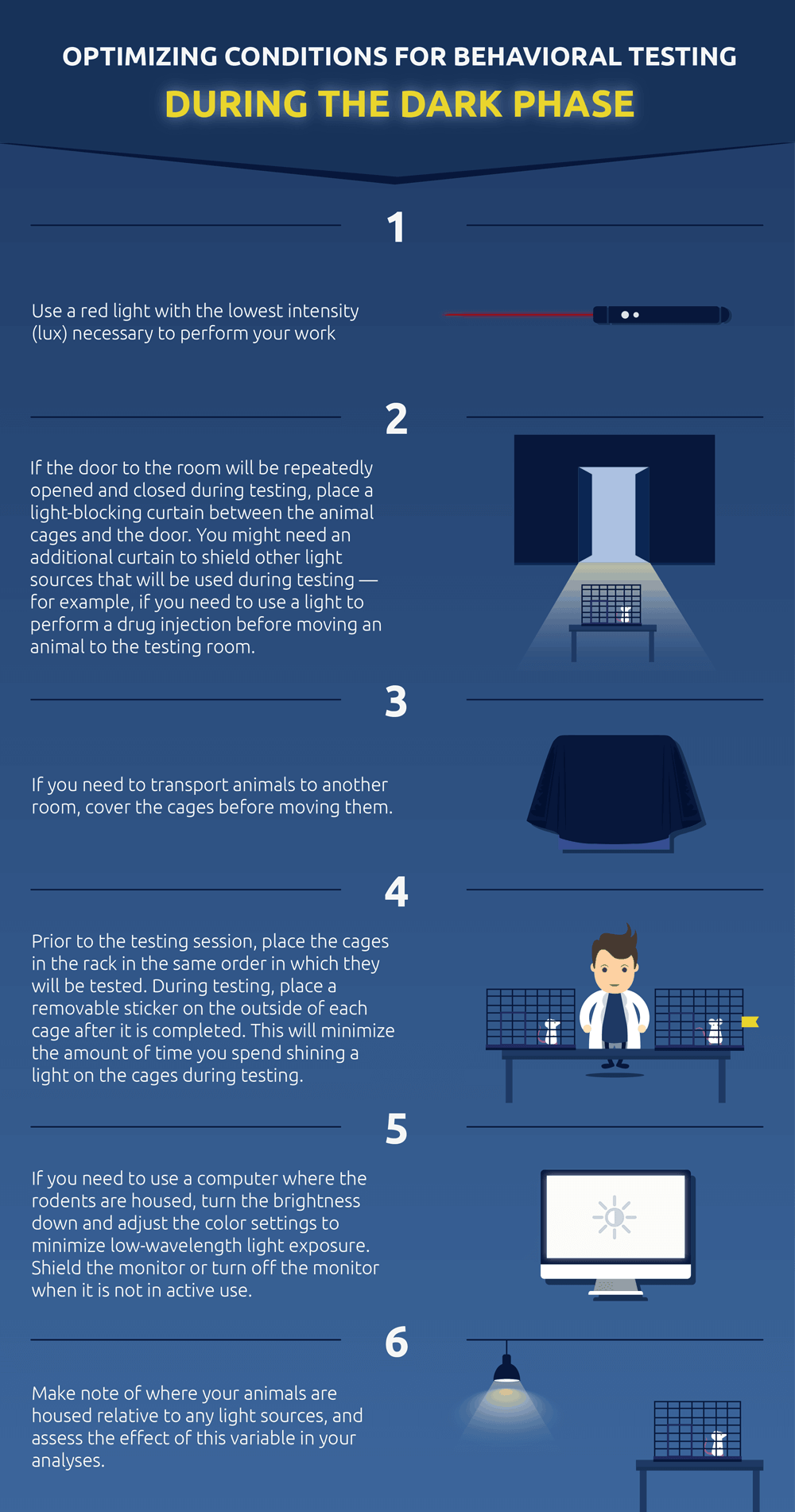Imagine someone woke you up in the middle of the night and asked you to take an exam, go for a drive in a new town, or meet a group of new colleagues. How do you think you would perform? Most of us would not be at our best. For the same reasons, rodent behavioral testing often needs to be conducted during the active phase of the circadian cycle to obtain optimal results.
During the active phase, mice and rats exhibit higher corticosterone levels, increased exploratory behavior, and a predominance of active social behaviors[1]. Corticosterone is the main stress hormone in mice. Like its human correlate cortisol, corticosterone undergoes diurnal changes and reaches a peak at the beginning of the active cycle[2].
Corticosterone and other hormones serve to increase an animal’s exploratory activity, which will produce higher levels of locomotion in a behavioral test. Rodents are more likely to approach and interact with conspecifics during the active phase, and show increased levels of aggression[2]. Anxiety and depressive behaviors have also been shown to be dependent on the time of day[3]. Just as people perform poorly on intelligence tests at night, rodents perform better on tests of cognition during the active phase[4].
However, unlike humans, rodents are nocturnal, and thus the active phase of their circadian cycle corresponds to their “night time” or dark phase. This presents several problems for researchers who need to test circadian-dependent rodent behaviors.
The first problem is that, unless you want to be in the lab at 3 am, the animals must be put on an adjusted light-dark cycle prior to testing. Ideally, the times of lights-on and -off in the vivarium and testing room can be shifted so that the dark phase corresponds to a time when researchers are normally in the laboratory. This adjustment must be made in advance of testing to allow time for the animals’ circadian rhythms to adapt to the new schedule.
A second major problem of testing during the dark phase is that incidental light exposure during the experiments can cause circadian disruption and potentially influence behavior[5]. This begs the question: how should we illuminate the mouse room?
It was long assumed that rodents could not detect light in the red spectrum (650 nm or higher). Most animal facilities use red film to cover the windows in the vivarium doors, and specialized red light tubes and window glass can be purchased commercially for vivarium use. Behavioral researchers frequently use a red headlamp or a table lamp with a red bulb during their experiments, and valid results have been reported using these conditions.
However, more recent studies have demonstrated disruptions in the circadian rhythm from intermittent red light exposure, suggesting that rodents may be more sensitive to red light than previously believed[6]. This red light exposure can suppress melatonin secretion and alter metabolism at levels as low as 0.2 lux[7].
While the use of red light is still the best option for minimizing circadian disruptions, these results suggest that caution should be used in designing experimental setups, and that the lux intensity should be minimized. You may wish to consider the following suggestions in your experimental design:
- Use a red light with the lowest intensity (lux) necessary to perform your work.
- If the door to the room will be repeatedly opened and closed during testing, place a light-blocking curtain between the animal cages and the door. You might need an additional curtain to shield other light sources that will be used during testing — for example, if you need to use a light to perform a drug injection before moving an animal to the testing room.
- If you need to transport animals to another room, cover the cages before moving them.
- Prior to the testing session, place the cages in the rack in the same order in which they will be tested. During testing, place a removable sticker on the outside of each cage after it is completed. This will minimize the amount of time you spend shining a light on the cages during testing.
- If you need to use a computer where the rodents are housed, turn the brightness down and adjust the color settings to minimize low-wavelength light exposure. Shield the monitor or turn off the monitor when it is not in active use.
- Make note of where your animals are housed relative to any light sources, and assess the effect of this variable in your analyses.
While completely avoiding light exposure at night is not possible, a carefully designed experiment will minimize its impact on experimental outcomes.
References
- Yang M, Weber MD, Crawley JN. (2008) Light phase testing of social behaviors: not a problem. Front Neurosci. 2(2):186-91.
- Haller J, Millar S, van de Schraaf J, de Kloet RE, Kruk MR. (2000) The active phase-related increase in corticosterone and aggression are linked. J Neuroendocrinol. 12(5):431-6.
- Verma P, Hellemans KG, Choi FY, Yu W, Weinberg J. (2010) Circadian phase and sex effects on depressive/anxiety-like behaviors and HPA axis responses to acute stress. Physiol Behav. 2010 Mar 3;99(3):276-85.
- Roedel A, Storch C, Holsboer F, Ohl F. (2006) Effects of light or dark phase testing on behavioural and cognitive performance in DBA mice. Lab Anim. 40(4):371-81.
- Bedrosian TA, Vaughn CA, Weil ZM, Nelson RJ. (2013) Behaviour of laboratory mice is altered by light pollution. Animal Welfare 22: 483-487.
- Hofstetter JR, Hofstetter AR, Hughes AM, Mayeda AR. (2005) Intermittent long- wavelength red light increases the period of daily locomotor activity in mice. J Circadian Rhythms. 3:8.
- Dauchy RT, Wren MA, Dauchy EM, Hoffman AE, Hanifin JP, Warfield B, Jablonski MR, Brainard GC, Hill SM, Mao L, Dobek GL, Dupepe LM, Blask DE. (2015) The influence of red light exposure at night on circadian metabolism and physiology in Sprague-Dawley rats. J Am Assoc Lab Anim Sci. 54(1):40-50.

